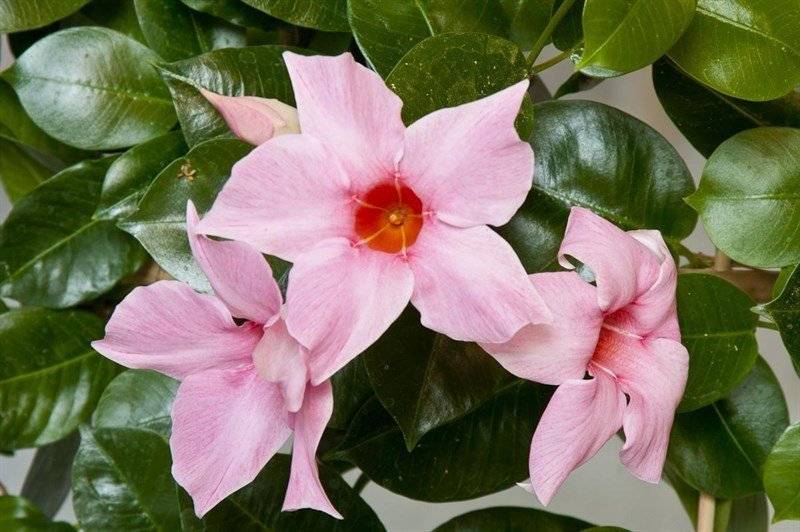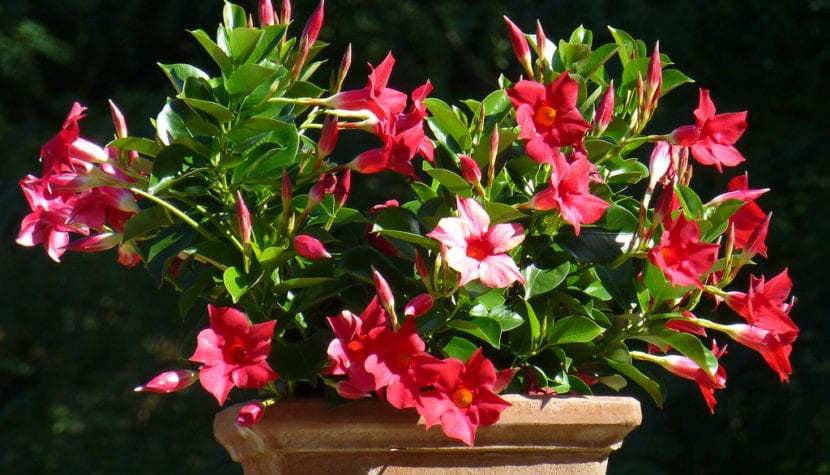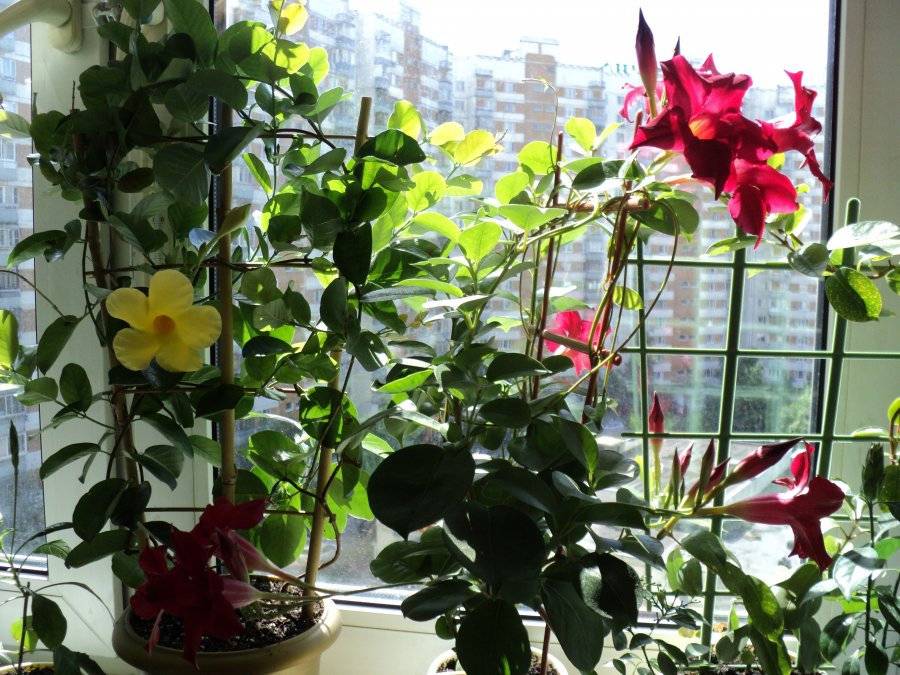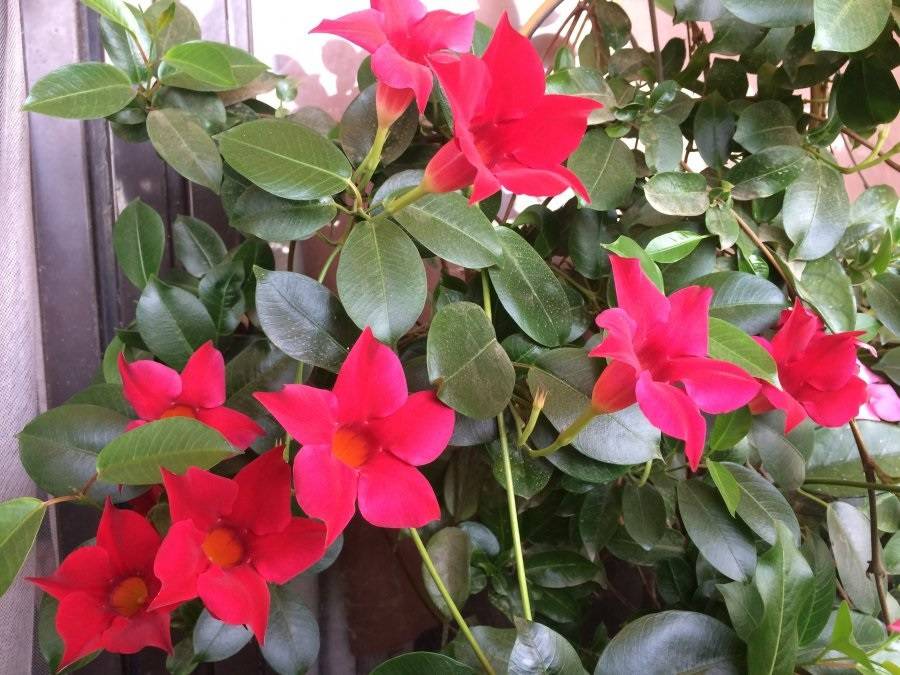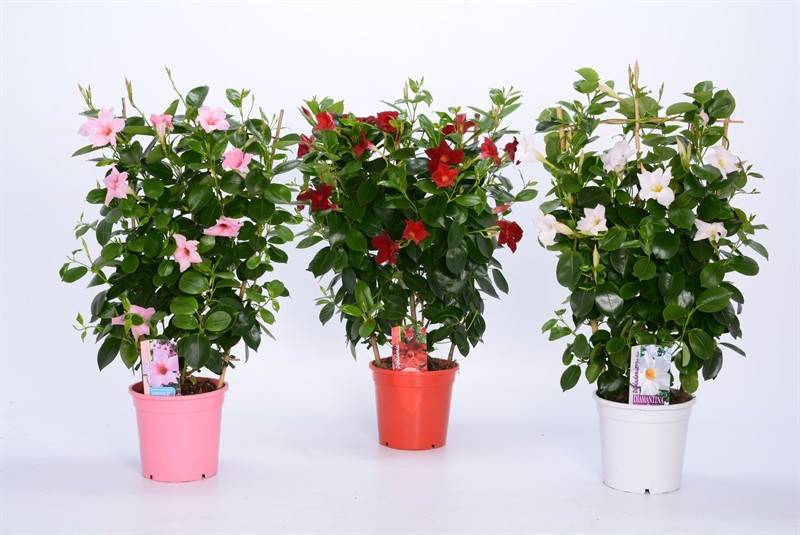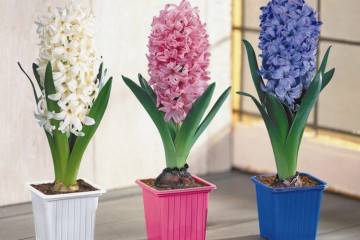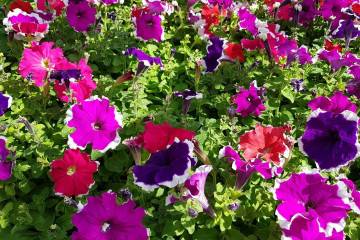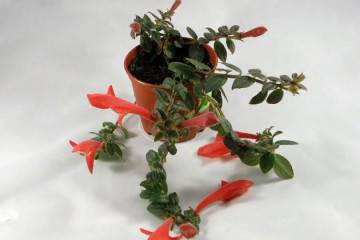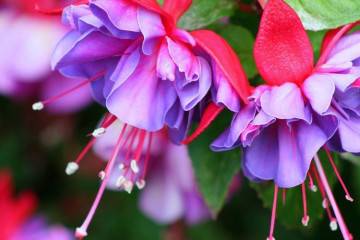Diplomas - growing and caring at home
Content:
Not so long ago, the flower of dipladenia (Dipladenia) began to gain popularity, which has an attractive appearance due to the many colors of saturated colors. This tropical vine can be grown not only in personal plots, but also in an apartment. Like any exotic plant, it requires careful attention and special care, but the conditions necessary for a flower cannot be called impossible.
Description and characteristics
Dipladenia is a flower representing an evergreen perennial liana. Other plant names: Bolivian rose, Brazilian balsam, Mandeville or Chilean jasmine. Curly, smooth shoots are covered with lush green leaves and funnel-shaped fragrant flowers about 10 cm in diameter. On one lash of a plant, there can be up to fifty inflorescences. The color of the flowers is varied: they can be crimson, yellow, pink or cream. The flowering period lasts from early spring to about mid-autumn.
In nature, diploidia grows mainly in South America. When grown in open ground, the shoots of the flower stretch up to 5 m in length. The intensity of the annual growth of the branches is about 70 cm in length. At home, the size of the creeper can be adjusted by pruning. With proper care, the Mandeville Dipladenia will become the queen of indoor vines.
Diplomas: growing and care
Diplomas are very responsive to care. Knowing the basic requirements and fulfilling them, even the most experienced florist can cope with this task.
Temperature
Being a tropical plant, diplodenia prefers a temperature regime in the range of 21-25 ºС. Liana is not uncomfortable with hot weather, if, at the same time, a sufficient level of humidity is maintained in the place where it is grown. For the winter of diplomatic life, it is necessary to organize favorable conditions for rest. It is desirable that the temperature does not exceed 15 ºС.
Lighting
Mandeville, although it develops better in a well-sunlit place, easily tolerates some shading. It is recommended to place it on the windowsills on the south, south-east or east side of the apartment. If cloudy weather is established during the growing season, then the day of the plant should be extended with additional lighting.
Watering
During the summer, the Bolivian rose needs frequent, but not excessive moisture to the top layer of the earth. For this, soft rainwater, filtered or distilled, is used. You can acidify it a little with lemon juice or acid.
Spraying
The tropical plant responds gratefully to frequent spraying, at least 1 time per day. For this, they also take soft water at room temperature. Carrying out the procedure, you need to try not to get on the flowers and buds, so as not to spoil the decorative appearance of the Brazilian balsam.
Humidity
If the dipladania is grown in an apartment with dry air, it is necessary to ensure an increase in the humidity level. To do this, a container with water can be placed near the creeper. A flat tray with pebbles or sphagnum is also suitable, on the bottom of which water is periodically poured.
Priming
Bolivian rose requires nutritious soil with an increased acidity level. You can use commercially available azalea soil or prepare the mixture yourself using the following ingredients in a 2: 1: 1: 1 ratio:
- garden land;
- leafy land;
- peat;
- small pebbles or perlite.
Top dressing
Mandeville spends a lot of energy on flowering and growth, therefore, with the onset of spring, it must be fertilized about 2 times a month. In the summer months, the procedure is carried out more often - once every 10 days, and in the fall they gradually begin to reduce again. You can use a liquid complex preparation for flowering plants or the same one that is used for azaleas for feeding.
Support
Dipladenia, for which the ampelous form is undesirable due to the fragility of the shoots, should be located next to the wall or lean on a special stand, a ladder. Even if the Chilean jasmine is bush-shaped, its shoots still need a guiding frame. It is much easier to provide proper care for an ampelous diploma in the garden than at home.
Pot
When choosing a suitable container for vines, it is recommended to give preference to wide flowerpots of small height and volume. This is due to the fact that the root system of the Bolivian rose does not tolerate excessive moisture, which is inevitable when using large pots and tubs. Transplanting a flower as it grows, pick up a container 2-3 cm larger than the previous one.
Features of winter care
Diplomacy requires assistance with wintering, which lasts from late autumn to early spring. For this, a number of requirements must be met:
- towards the end of summer, watering of the flower is gradually reduced, by winter reducing it to a minimum level - no more than 1 time in 10-14 days;
- at the end of autumn, old shoots are pruned by 2/3 of the length. If the lash bifurcates, then the distance is measured not from the root collar, but from the branching point;
- the plant is placed in a cool room with a temperature of 12-15 ºC until spring.
Transfer
A young vine grows so fast that in the first two years it may need to be transplanted 2-3 times a year. The procedure for transplanting an older Brazilian balsam should be carried out annually, preferably immediately after wintering. This should be done using a transfer method using a new larger pot with sufficient drainage holes. In extreme cases, it is necessary to replace the topsoil (about 4 cm).
Dormant period
For normal development and abundant flowering, Mandeville definitely needs a period of rest. The plant usually rests from January to March. At this time, the flower is transferred to a cool, sufficiently lit room, where the temperature regime does not exceed 15 ºС, but does not fall below 5 ºС. The liana is watered minimally: it is better to dry out the soil than excessive dampness, otherwise rotting of the root system is possible.
When the Bolivian rose blooms
At home, the flowering period of the plant is abundant and long: from March to the end of November. A young plant, obtained from a cuttings, blooms from the first year of life. A healthy adult liana is covered with 50-80 flowers at the same time, each of which does not fade within 10-14 days.
Pruning
The pruning procedure is carried out in March simultaneously with the transplant, as well as when preparing the plant for wintering. In this case, the following rules are taken into account:
- be sure to remove the mustache if they were formed during the time the vines were in a dark place;
- young branches are not touched when pruning, since it is on them that buds will appear later;
- if the flowering period has already begun, then it is better to postpone the procedure.
How Mandeville Reproduces
There are several ways to propagate Chilean jasmine at home. To do this, the plant is cut by cuttings, seeds are sown or the mustache is rooted after pruning.
Propagation by cuttings
Cutting is the easiest way to reproduce in diplodenia. There are two ways to get new plants from cuttings: planting in the ground or rooting in water. In both cases, the cut site is treated with a growth stimulant.
Seeds and whiskers
In flower shops, you can find Brazilian balsam planting material in the form of seeds or get a seed box from friends. In such cases, in order to get a new plant, you need to take into account certain rules for sowing seedlings:
- the use of a suitable slightly acidic loose soil;
- high air temperature (22-28 ºC);
- constant humidity level without stagnant water.
Such conditions will have to be maintained for 2-4 months until the seeds germinate.
It is much easier to propagate the plant with antennae. To do this, young unripe shoots are bent to the ground and pinned. When the roots appear, the young plant is separated from the mother plant and transplanted into a separate container in compliance with all transplantation requirements.
Possible problems
Diplomas, caring for which at home is complicated by her whimsicality, can bring a lot of anxiety to the grower. In order for the vine to grow and develop normally, it is important to know how to properly care for the flower and deal with possible pests and diseases.
Mealybug and powdery mildew
Most often, the Bolivian rose is attacked by mealybugs and powdery mildew infection. They can appear when using poor-quality water or soil, low air temperature, poor lighting, or from constant dust on the leaves. To get rid of them, the plant is treated with appropriate fungicides and insecticides, and in the future, the care of dipladenia is corrected.
You can recognize the appearance of pests by the following signs:
- withered leaves and sluggish shoots;
- deformation of flower petals;
- small mosquitoes periodically appear near flowers;
- white round blotches in the soil;
- white oval insects on leaves and stems.
Spider mites and whiteflies
The greatest damage to Mandeville is caused by spider mites and whiteflies, which appear when the conditions of keeping the plant are violated. With minor lesions, you can do with wiping the foliage with acidified water with the addition of soap. In more serious cases, it is worth using specialized tools.
Why do leaves turn yellow and fall
Withering and yellowing of leaves are the first signs of an illness or insect infestation. Seeing that the leaves have changed color, the plant should be removed from others and, after carefully examining, find out the cause. It may turn out that the vine is quite healthy, but there is a violation of the conditions of care that requires correction:
- irregular, excessive or poor watering;
- low air temperature.
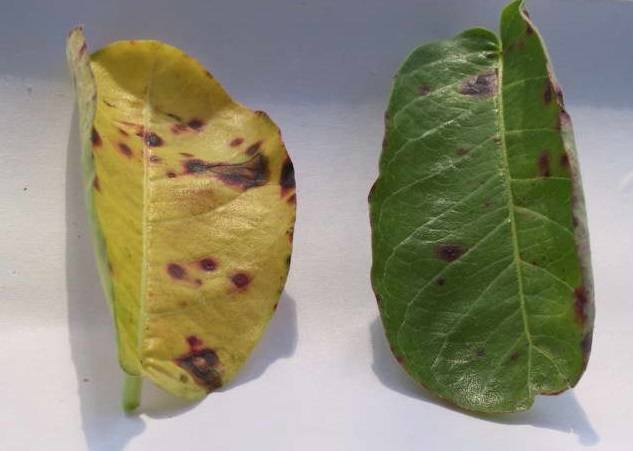
Yellowed leaves of diplodenia do not always indicate pest infestation or the appearance of an ailment.
Why Diplomacy Does Not Blossom
Inexperienced growers may find that Brazilian balsam refuses to bloom at home. Most often this is due to a lack of sunlight. In addition to this reason, the lack of flowering may be associated with a violation of the irrigation regime, insufficient feeding, neglect of airing the room, an incorrectly selected pot or too low air temperature. By adjusting the care, you can make the Mandeville bloom.
Disease prevention
As a prophylaxis for various diseases, the following measures can be applied:
- regularly inspect the vines;
- transplant the flower in a timely manner;
- remove dying plant parts;
- disinfect the pots and process the soil before planting;
- finding a diseased plant, quarantine it;
- maintain the required temperature during flowering and dormant periods.
Common varieties
The Bolivian rose has many varieties of liana-like shrubs that differ in appearance. Only a few of them are most widespread.
Shiny (Dipladenia splendens)
A large evergreen shrub, the stems of which grow up to 5 m and tend to curl at the tips. Young shoots are pubescent, mature ones become smooth. Leaves up to 20 cm in length, elongated heart-shaped with pronounced veins on short petioles. The flowers are deep pink.
Bolivian (Dipladenia bolewiensis)
Evergreen thermophilic liana with shoots of 4 m. Leaves are small oval, up to 8 cm in length, bright green. Flowers about 5 cm in diameter can be of different shades: from white to bright pink with a noticeable yellow throat.
Excellent (Dipladenia eximia)
Evergreen climbing vine with smooth reddish shoots. Elliptical leaves are saturated green no more than 3-4 cm. Flowers 7 cm in diameter are collected in clusters of 8-10 pcs. and painted pink-red.
Sandera (Dipladenia sanderi)
A fast-growing evergreen vine with smooth branches. Leaves are thick, oval, slightly pointed at the ends, 5 cm long. Flowers form clusters of 3-5 pcs. The color of this diplodemy is pink-red with a yellow throat.
Loose (Dipladenia laxa)
Deciduous vine with warty shoots, about 5 m long. Oval leaves, about 10 cm, bright green, slightly pubescent underneath. The flowers are large, 9 cm in diameter, with crimped cream-colored petals, they are collected in inflorescences up to 10 pcs.
Most popular types
There are just under 200 different species and varieties of vines in the world. The most popular of them are the following:
- yellow Allamandu;
- snow-white large-flowered Cosmos White;
- terry Cosmos of Roses;
- hybrid Parasol Stranes;
- Cosmos Crimson King;
- red Classic Red;
- milky white Laksa.
So, growing and caring for a diploma at home is not such a difficult task. Any indoor plant will require no less attention for itself, but not everyone is able to give such a long and abundant flowering as the Bolivian rose.
